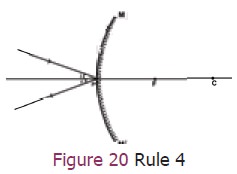Chapter: 9th Science : Light
Convex Mirror
Convex Mirror
1. Rules
for the construction of image formed by spherical mirrors
We have studied the image formation by a concave
mirror. Similarly, we can trace the path of light rays reflected by the convex
mirrors using four ‘rules’.
Rule 1: A ray
of light which is parallel to the principal
axis of a convex mirror appears to be coming from its principal focus,
after reflection from the mirror (Figure 17).

Rule 2: A ray of
light going towards the centre of
curvature is reflected back along the same path (Figure 18).

Rule 3: A ray of
light going towards the principal focus of a convex mirror becomes
parallel to the principal axis after reflection (Figure 19).

Rule 4: A ray of
light which is incident at the pole
of a convex mirror is reflected back making the same angle with the principal
axis (Figure 20).

2. Image formation in a convex mirror
Any two rays can be chosen to draw the position of
the image in a convex mirror (Figure 21).
1st ray: the ray that is parallel to the principal
axis (rule 1) and
2nd ray : the ray that appears to pass through the
centre of curvature (rule 2).
Note: All rays behind the convex mirror shall be
shown with dotted lines.

The ray OA parallel to the principal axis is
reflected along AD. The ray OB retraces its path. The two reflected rays
diverge but they appear to intersect at I when produced backwards. Thus II′ is the virtual image of the
object OO′. It is
virtual, erect and smaller than the object.
Sample Problem 3
A car is fitted with a convex mirror of focal
length 20 cm. Another car is 6 m away from the first car.
a) Find the
position of the second car as seen in the mirror of the first
b) What is
the size of the image if the second car is 2 m broad and 1.6 m high?
Focal length =
20 cm (convex mirror)
Object distance = -6m
= - 600 cm
Image distance v =?
Calculation for position of image using mirror
equation

b) Size of the image

3. Uses of convex mirror
Convex mirrors are used as rear-view mirrors in
vehicles. It always forms a virtual, erect, small-sized image of the object. As
the vehicles approach the driver from behind the size of the image increases.
When the vehicles are moving away from the driver, then image size decreases. A
convex mirror provides a much wider field of view* compared to plane mirror.

More to know by observation
1) Have you ever
seen the dish antenna used at your home? What is the shape of the antenna? Is
it convex or concave? Why?
2) Look
around your environment. Observe all the spherical objects (having reflecting
surfaces) and record your observation (for example soap bubble).
Crossword puzzle

Across
3. Kind of image formed when rays from the mirror
converge.
4. Rays from an object at infinity.
6. Converging mirror.
9. Line perpendicular to the surface at the point
of incidence.
11. Diameter of circular rim of spherical mirror.
Down
1. Reflection of light into many directions by
rough objects.
2. The turning back of light at the shining surface
of substance.
5. _______ of reflection: angle of incidence (i) =
angle of reflection (r).
7. Centre of curvature is on the side opposite to
the reflecting surface of mirror.
8. Image of an object in a plane mirror.
10. _______ of reflection angle between the
reflected ray and the normal at thepoint of contact.
12. Nature of image formed by convex mirror.
Related Topics